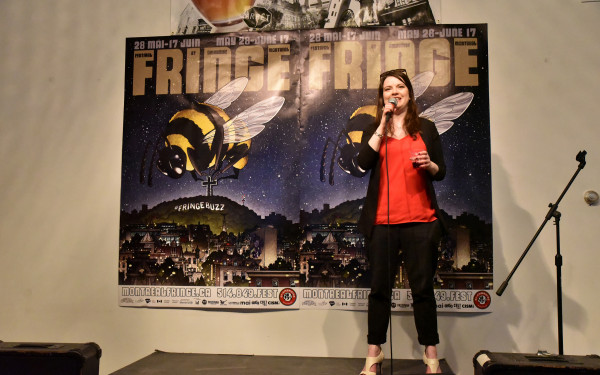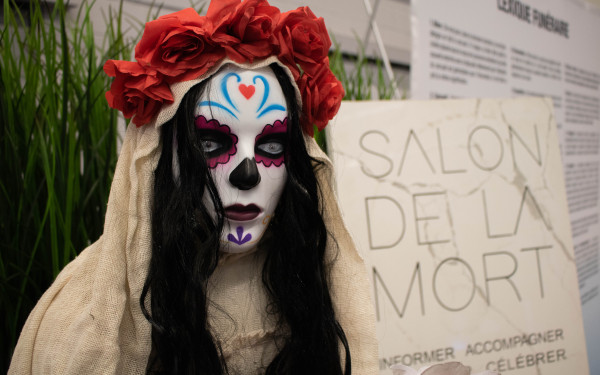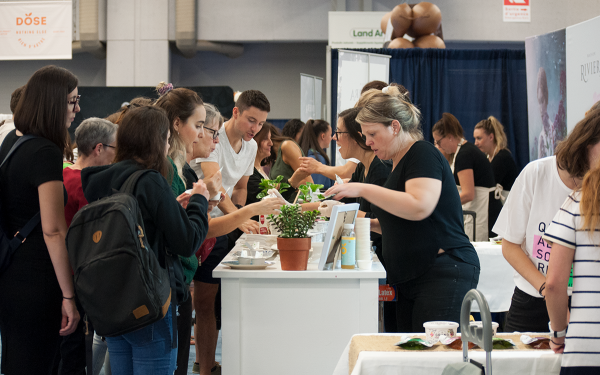Building a Festival
A Behind-the-Scenes Look at the History of POP Montreal
On the seventh floor of a large industrial building in the Mile End, buried amidst an eclectic hodge-podge of businesses—including an Israeli MMA self-defence studio, a textile factory and, quite possibly, a porn studio—you will find a loft that is slightly smelly and packed with boxes of vitamin water, cases of beer and massive amounts of freshly printed t-shirts and programs. The room is bustling, as people work busily in pod-like formations scattered across the room.
This is where POP Montreal is made.
This room, these people, and their time and effort (lots of both) are where and how this year’s tenth edition of the festival has come to be.
If you glanced around the room, you’d have trouble finding anyone sporting a suit or tie, and you’d also have tough luck finding anyone pushing the age of 35—seeing as the majority of the staff are still in their early-to mid-twenties.
Eight salaried staff work year-round to direct, produce, curate, publicize and program all segments of the festival. Volunteers and interns are then recruited and hired to help as the date of the actual festival draws nearer, hence the current chaos and crowding of the loft.
“It’s important that we hire young people that have energy and a vision,” said Dan Seligman, the festival’s current creative director, who co-founded the festival at age 25. “We need to remain true to who we are and where we came from. We need to reflect the spirit of the festival.”
POP Montreal, born 10 years ago from an idea suggested in a follow-up call after an impromptu train encounter, has been a learning process since the very beginning.
The first edition of the festival was put together by Seligman and Peter Rowan (the man he started chatting with that fateful day on the train) in less than six months, in an office whose rent was paid for by a series of beer-selling fundraisers.
The festival returned annually, eventually becoming a non-profit organization in its third year.
Gradually, POP evolved from a music festival into the multi-faceted smorgasbord of art events it is now.
FilmPOP debuted as nothing more than a one-film showing with Cinéma du Parc and the predecessor of the POP Symposium was a 10-person quasi-discussion at Casa del Popolo.
“The whole thing really developed organically,” said Seligman. “A lot of the time ideas just came from the ground up. When someone was really passionate about something and wanted to make it happen, we were there to help facilitate that.”
Seligman said that while at the beginning, the organizers were able to just hit the ground running, they eventually realized that they needed to buckle down on their organizational skills—something they are still trying to improve today.
“We went from being a bunch of kids working for free and volunteering, to becoming an actual work experience,” he said. “I now have to deal with issues like people wanting dental care in addition to planning the rest of the festival.”
Despite growing and getting older, the festival has been able to maintain its youth through its staff.
“This festival has become somewhat of an institution, almost like a micro-economy within the culture of Montreal that is contributing to the art and cultural scene here,”
–Dan Seligman
POP Montreal’s creative director
“As young people, we are closer to untarnished ideals,” said Patricia Boushel, POP’s producer. “Many of us have not yet encountered any institutional barriers or bureaucratic impediments that have become commonplace when you are actually working in major institutions and systems.”
She explained that it is this sort of idealism that helps the festival renew itself each year, as successive generations of POP staff remain sensitive to the role they play in the community.
While the festival has certainly done its share to give back, it has been lucky enough to receive much in the form of donations.
“Everything in the office has been given to us, by our family, our friends, by strangers,” said Boushel, explaining that this sort of involvement is analogous to how the entire festival comes together.
“I think we are just one big assembly of donated parts that is now kind of legitimizing itself through its solidifying relationships with the governmental and cultural institutions that are responsible for actually helping us fund our initiative.”
And Seligman said he would largely like to keep it that way. While he wants the festival to continue to improve, he hopes it remains a grassroots organization and stays true to the local and cultural milieu that has helped build it.
That said, one of Seligman’s points of pride is the fact that he has created a work environment that allows him to provide jobs and experience.
“This festival has become somewhat of an institution, almost like a micro-economy within the culture of Montreal that is contributing to the art and cultural scene here,” he said.
“We are hiring and contributing to society in a way that is both helpful and interesting. I’m proud of that.”
This article originally appeared in Volume 32, Issue 04, published September 20, 2011.

__550_374_90.jpg)
_600_832_s.png)

2_600_375_90_s_c1.jpg)


